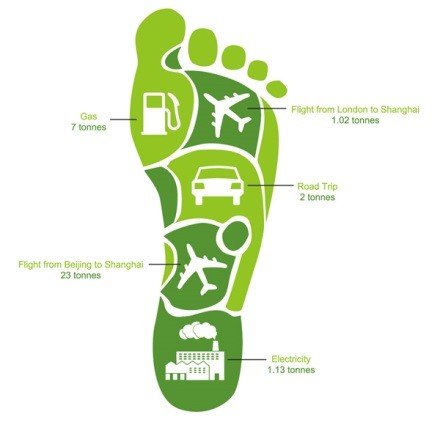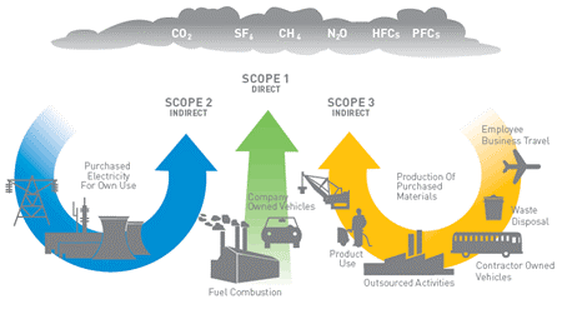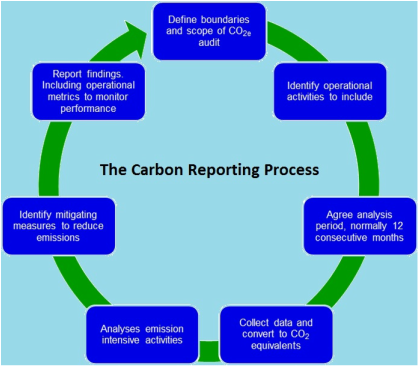Greenhouse Gas Reporting

Climate change is increasingly
recognised as a major challenge. It is widely accepted that the greenhouse gas
emissions caused by humans are having a negative impact on the environment.
The most important greenhouse gas, arising from human activity, is carbon dioxide (CO2). Virtually all human activities cause the CO2 emissions that lead to climate change. By using electricity generated from fossil fuel power stations, burning gas for heating or driving a petrol or diesel car, every person is responsible for CO2 emissions.
Furthermore every product or service that humans consume indirectly creates CO2 emissions; energy is required for their production, transport and disposal. These products and services may also cause emissions of other greenhouse gases. Understanding and addressing the full range of our impact is crucial for the effects of climate change to be minimised. The total set of greenhouse gas emissions caused directly and indirectly by an individual, organisation, event or product is commonly called their carbon footprint. Establishing the carbon footprint of an organisation can be the first step in a programme to reduce the emissions it causes.
Virtually all human activities cause the CO2 emissions that lead to climate change.
The term carbon footprint is commonly used to describe the total amount of CO2 and other greenhouse gas (GHG) emissions for which an individual or organisation is responsible. Footprints can also be calculated for events or products.
The full footprint of an organisation encompasses a wide range of emissions sources from direct use of fuels to indirect impacts such as employee travel or emissions from other organisations up and down the supply chain. When calculating an organisation’s footprint it is important to try and quantify as full a range of emissions sources as possible in order to provide a complete picture of the organisation’s impact. In order to produce a reliable footprint, it is important to follow a structured process and to classify all the possible sources of emissions thoroughly. A common classification is to group and report on emissions by the level of control which an organisation has over them. On this basis, greenhouse gas emissions can be classified1 into three main types or Scopes:
The most important greenhouse gas, arising from human activity, is carbon dioxide (CO2). Virtually all human activities cause the CO2 emissions that lead to climate change. By using electricity generated from fossil fuel power stations, burning gas for heating or driving a petrol or diesel car, every person is responsible for CO2 emissions.
Furthermore every product or service that humans consume indirectly creates CO2 emissions; energy is required for their production, transport and disposal. These products and services may also cause emissions of other greenhouse gases. Understanding and addressing the full range of our impact is crucial for the effects of climate change to be minimised. The total set of greenhouse gas emissions caused directly and indirectly by an individual, organisation, event or product is commonly called their carbon footprint. Establishing the carbon footprint of an organisation can be the first step in a programme to reduce the emissions it causes.
Virtually all human activities cause the CO2 emissions that lead to climate change.
The term carbon footprint is commonly used to describe the total amount of CO2 and other greenhouse gas (GHG) emissions for which an individual or organisation is responsible. Footprints can also be calculated for events or products.
The full footprint of an organisation encompasses a wide range of emissions sources from direct use of fuels to indirect impacts such as employee travel or emissions from other organisations up and down the supply chain. When calculating an organisation’s footprint it is important to try and quantify as full a range of emissions sources as possible in order to provide a complete picture of the organisation’s impact. In order to produce a reliable footprint, it is important to follow a structured process and to classify all the possible sources of emissions thoroughly. A common classification is to group and report on emissions by the level of control which an organisation has over them. On this basis, greenhouse gas emissions can be classified1 into three main types or Scopes:
Scope
1. Direct emissions that result from activities the organisation controls
Most commonly, direct emissions will result from combustion of fuels which produce CO2 emissions, for example the gas used to provide hot water for the workspace. In addition, some organisations will directly emit other greenhouse gases. For example, the manufacture of some chemicals produces methane (CH4) and the use of fertiliser leads to nitrous oxide (N2O) emissions.
Scope 2. Emissions from the use of electricity
Workplaces generally use electricity for lighting and equipment. Electricity generation comes from a range of sources, including nuclear and renewables. However, in the UK around 75% is produced through the combustion of fossil fuels. Although the organisation is not directly in control of the emissions, by purchasing the electricity it is indirectly responsible for the release of CO2.
Scope 3. Indirect emissions from products and services
Each product or service that is purchased by an organisation is responsible for emissions. So the way the organisation uses products and services affects its carbon footprint. For example, a company that manufactures a product is indirectly responsible for the carbon that is emitted in the preparation and transport of the raw materials. Downstream emissions from the use and disposal of products can also be indirectly attributed to the organisation. It is clear, therefore, that producing a full footprint covering all three types of emissions can be quite a complex task. A further complexity in understanding published footprints is that they are rarely comparable for the following reasons:
The reasons for needing a carbon footprint will determine which approach is the most appropriate.
There are typically two main reasons for wanting to calculate a carbon footprint:
Calculating an organisation’s carbon footprint can be an effective tool for ongoing energy and environmental management. If this is the main reason that an organisation requires a carbon footprint, it is generally enough to understand and quantify the key emissions sources through a basic process, typically including gas, electricity and transport.
This approach is relatively quick and straightforward. Having quantified the emissions, opportunities for reduction can be identified and prioritised, focusing on the areas of greatest savings potential.
Footprinting for accurate reporting
Organisations increasingly want to calculate their carbon footprint in detail for public disclosure in a variety of contexts:
Most commonly, direct emissions will result from combustion of fuels which produce CO2 emissions, for example the gas used to provide hot water for the workspace. In addition, some organisations will directly emit other greenhouse gases. For example, the manufacture of some chemicals produces methane (CH4) and the use of fertiliser leads to nitrous oxide (N2O) emissions.
Scope 2. Emissions from the use of electricity
Workplaces generally use electricity for lighting and equipment. Electricity generation comes from a range of sources, including nuclear and renewables. However, in the UK around 75% is produced through the combustion of fossil fuels. Although the organisation is not directly in control of the emissions, by purchasing the electricity it is indirectly responsible for the release of CO2.
Scope 3. Indirect emissions from products and services
Each product or service that is purchased by an organisation is responsible for emissions. So the way the organisation uses products and services affects its carbon footprint. For example, a company that manufactures a product is indirectly responsible for the carbon that is emitted in the preparation and transport of the raw materials. Downstream emissions from the use and disposal of products can also be indirectly attributed to the organisation. It is clear, therefore, that producing a full footprint covering all three types of emissions can be quite a complex task. A further complexity in understanding published footprints is that they are rarely comparable for the following reasons:
- Despite emerging international
standards not all organisations follow the same approach to calculating their
footprint or classify their emissions in the same way
- Some footprints are expressed on a time
period basis, such as the footprints of an individual or company which are
typically measured annually. Others are expressed on a unit basis, such as per
event or product purchased
- Carbon footprints are typically
calculated to include all greenhouse gases and are expressed in tonnes of CO2
equivalent (tCO2e). However, others calculate the footprint to
include CO2 only and express the footprint in tCO2
(tonnes of CO2).
The reasons for needing a carbon footprint will determine which approach is the most appropriate.
There are typically two main reasons for wanting to calculate a carbon footprint:
- To manage the footprint and reduce emissions over time
- To report the footprint accurately to a third party.
Calculating an organisation’s carbon footprint can be an effective tool for ongoing energy and environmental management. If this is the main reason that an organisation requires a carbon footprint, it is generally enough to understand and quantify the key emissions sources through a basic process, typically including gas, electricity and transport.
This approach is relatively quick and straightforward. Having quantified the emissions, opportunities for reduction can be identified and prioritised, focusing on the areas of greatest savings potential.
Footprinting for accurate reporting
Organisations increasingly want to calculate their carbon footprint in detail for public disclosure in a variety of contexts:
- Legal requirement / Mandatory reporting – Directors report for listed companies
- For CSR or marketing purposes
- To fulfil requests from business or retail customers, or from investors
- To ascertain what level of emissions
they need to offset in order to become ‘carbon neutral’.
For these purposes, a more robust approach is needed, covering the full range of emissions for which the organisation is responsible. It may also be appropriate for the calculation to be independently verified to ensure that the methodology has been correctly used and that the results are accurate. (See ISO 14064 Part 1 Specification with guidance at the organization level for quantification and reporting of greenhouse gas emissions and removals) If you need further guidance or assistance contact MET



